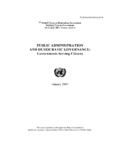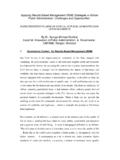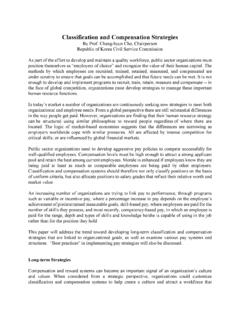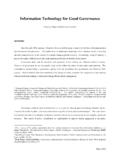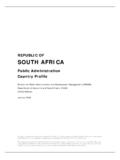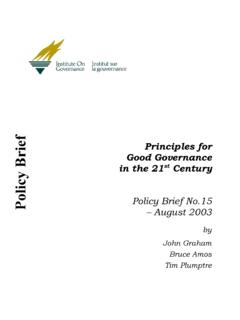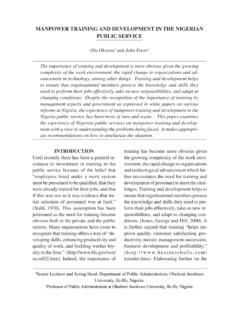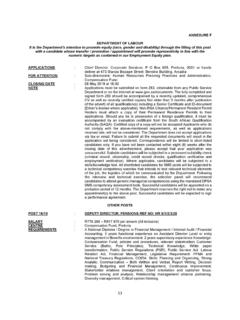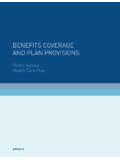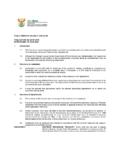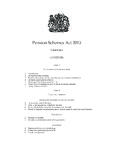Transcription of SALARIES AND BENEFITS - United Nations
1 SALARIES AND BENEFITSIN THE public SERVICEP rivate Bag X916 Pretoria 0001 Tel: +27(0) 12 336 1000 Fax: +27(0) 12 326 Bag X9148 Cape Town 8000 Tel: +27(0) 21 467 5120 Fax: +27(0) 21 465 leader in public Service ExcellenceMISSION Supporting the Minister in leading public service administration Providing professional advice and support to ensure public service excellenceVALUE STATEMENTAn examplary, professional, ethical and accountable department embodying theprinciples of Batho Pele and committed to Service Excellence. Providing good governance nationally, on the African Continent and Globally Introduction I1. General annual adjustments 1 SALARIES and potential packages of employees on salary levels 1 to 10: public Service Act appointees 1 Guaranteed total packages of employees on salary Levels 11 and 12: public Service appointees 32. Occupation specific dispensation for identified occupations 5 Nurses 6 Educators 7 Legally qualified employees 73.
2 Pension BENEFITS 94. Medical BENEFITS 145. Housing BENEFITS 176. Service bonus 18 TABLE OF CONTENTS7. Leave dispensation 19 Annual leave 19 Beneficiaries of leave payout in the event of death 20 Normal sick leave 20 Acceptance of medical certificates 21 Temporary incapacity leave 22 Acceptance of medical certificates 23 Leave for occupational injuries and diseases 23 Maternity leave 23 Adoption leave 23 Family responsibility leave 24 Special leave 24 Leave for Office Bearers or Shop Stewards of recognised Employee organizations 24 Unpaid leave 248. Working time 25 Averaging of hours of work 25 Compensation for ordinary work performed on a Sunday and/or public holiday 25 Night work in the public Service 25 Overtime work 26 The payment rate for overtime 269.
3 Relevant telephone numbers and websites for further information 27 This booklet on SALARIES and BENEFITS in the public Service was developed with the intention of explaining further the SALARIES and BENEFITS government is offering to public servants. Through the 2008/09 salary adjustments, government has taken account of all its spending priorities, including social development, addressing crime issues, infrastructure investment and better service delivery for the communities in the pursuit of a better life for all. In the midst of all these priorities, government has come up with a comprehensive remuneration package that is prudent, forward looking and paves the way towards improving service delivery and public service performance and at the same time, ensuring improved conditions of service for all public servants. The principles underpinning the 2008/09 salary adjustments to the public servants include the following: general salary increases that keep pace with inflation so that the buying power of public servants is not compromised and additional increases that are linked to performance and service delivery; the attraction and retention of skills in the public service through the introduction of occupation specific dispensation (OSDs); and growing the capacity of the State through job creation.
4 The housing allowance will, once fully implemented, increase the salary for the lowest earner in the public service by approximately 15%.Furthermore, employees further benefited with regard to the introduction of the housing allowance and the free medical cover on the Sapphire Option for employees on salary level 1-5 who are members of Government Employees Medical Scheme (GEMS). INTRODUCTIONIIn terms of the multi-term agreement, Government is of the view that it is beneficial for both the employer and the employees, as it deals with the package of BENEFITS for public servants and not only salary adjustments. A multi-term wage agreement brings about stability in the planning for personnel expenditure, while ensuring that public servants receive real wage increases or at least inflation adjustments on their General annual adjustments These general annual salary adjustments include the cost-of-living adjustment, annual pay progression and grade progression.
5 Employees qualify for pay progression based on satisfactory performance. Grade progression will be awarded to qualifying employees in terms of the specific Occupation Specific Dispensation. The purpose of the annual cost-of-living adjustments is to preserve the buying power of the employees, in order to ensure that their SALARIES are not eroded by inflation. The prevailing wage agreement provides for an adjustment effective from 1 July 2008 based on projected CPI-X for the period 1 April 2008 to 31 March 2009, plus an additional 1% real SALARIES and potential total packages of employees on salary levels 1 to 10: public Service Act appointees. Employees in the public Service qualify for a guaranteed package that includes basic salary (notch), the annual service bonus (1/12 of basic salary) and the Employer contribution to the Government Employees Pension Fund (GEPF).
6 The guaranteed and potential packages are outlined in the table (next page). The amounts are reflected in Rands per AND BENEFITS IN THE public Guaranteed total packages of employees on salary levels 11 and 12: public Service Act appointees** These packages already include the BENEFITS referred to above for employees on salary levels 1 to 10, basic salary, employer s contribution to the GEPF and a flexible portion. Employees are permitted to structure these packages within certain parameters, employees on salary levels 11 and 12 have a choice between, 75/76 (set 1) or 70 (Set 2) pensionable income. The flexible portion may be structured as follows: A maximum of 25% of total package for car allowance; Medical contribution in line with the tax caps determined by the Minister of Finance; 13th Cheque (service bonus) calculated as 1/12 of the basic salary; Housing allowance any amount; and/or Non-pensionable Cash allowance any amount, normally the balance of the flexible portion that is not structured3 Examples of packages of public servants: This means that the total potential package for a - Cleaner graded on salary level 2 ranges between R90 081 to R96 081 per annum the BENEFITS constitute 47% to 49% of the potential package Scientist graded on salary level 10 ranges between R295 978 to R338 446 per annum the BENEFITS constitute 25% to 27% of the potential package Labour Relations specialist graded on salary level 12 ranges between R407,745 to R472,758.
7 This is a total package in Middle Management Service. 42. In order to enable government to recruit and retain professionals, the wage agreement provides, amongst others, for the development of occupational specific dispensations for identified categories of staff. The OSDs are underpinned by the following core principles: Unique salary structures per occupation; SALARIES of occupational categories will, where necessary, be aligned to the market; Centrally determined grading structures and broad job profiles; Adequate career pathing opportunities, which is a forward looking plan to systematically increase SALARIES of public servants after pre-determined periods based on specific criteria such as performance, qualification, scope of work, experience, etc.; and Pay progression within the salary band and grade progression OSDs for all the categories of Nurses, Educators and Legally qualified employees have already been SPECIFIC DISPENSATIONS (OSDs) FOR IDENTIFIED Nurses The position of a Professional Nurse in a General ward (normal performer) is as follows in terms of the unique remuneration structure and progression opportunities in terms of the OSD.
8 The positions of a Professional Nurse in an identified Specialty ward or a Primary Health Care Nurse (normal performer) are as follows in terms of the unique remuneration structure and progression opportunities in terms of the Educators The position of an Educator (M+4)) (new entrant) is as follows in terms of the unique remuneration structure of the Legally qualified employees The position of a Senior Assistant State Attorney (normal per former) is as follows in terms of the unique remuneration structure and progression opportunities in terms of the OSD:7* Total packages of legal OSD The position of a Principal State Law Advisor (normal performer) is as follows in terms of the unique remuneration structure and progression opportunities in terms of the OSD:* A new total salary package (70/30) split was introduced for legally qualified employees. Employees on SMS levels who were translated to the OSD, translated to the new 70/30 total salary packages, of which the 70% constitutes pensionable salary and the 30% is the flexible PENSION All public service employees appointed on permanent basis are required as a condition of service, to become members of the Government Employees Pension Fund (GEPF).
9 Contribution rates: As at 1 April 2005, the State s contribution to the GEPF was set at 13% for civil servants and 16% for uniformed service employees. In return, members (employees) contribute of their monthly pensionable salary to the GEPF. Fund BENEFITS : The Fund provides BENEFITS on: Retirement. Resignation. Death; or The following BENEFITS are payable by the GEPF: Normal retirement: For members of the GEPF normal retirement age is 60 years unless the members employment contract or law governing the employment stipulates otherwise. Normal retirees with less than ten years pensionable service receive a lump sum cash benefit (gratuity) equal to the members accrual interest in the Fund. For retirees with ten or more years of pensionable years of service, a gratuity and a monthly pension (annuity). Early retirement: Under certain circumstances in terms of the public 9 PENSION BENEFITS3 Service Act 1994, as amended, members may retire early before their normal retirement age.
10 An early retiree with less than ten years pensionable service receives a gratuity equal to the retiree s actuarial interest in the Fund. For early retirees with ten or more years of pensionable service, annuities and gratuities are calculated according the same formula used for normal retirement, with a reduction of a third of one percent for each month between the dates of early retirement and normal : Years of pensionable service will be increased by 25 percent for each year of pensionable service after ten years for members of the In-telligence (NIA/SASS), Secret Service, uniformed members of the South African Police Service (SAPS), the South African National Defence Force (SANDF) and Correctional members of the SANDF under the age of 53 years, will receive a gratuity increased by an additional 12 percent at retirement. Resignation: A member is entitled to receive a lump sum cash benefit on resignation or if discharged due to misconduct or illness or injury caused by the member s own doing.

